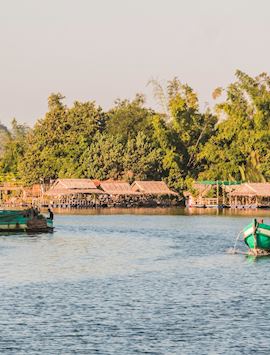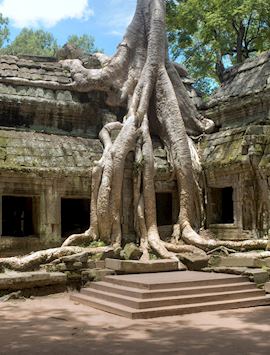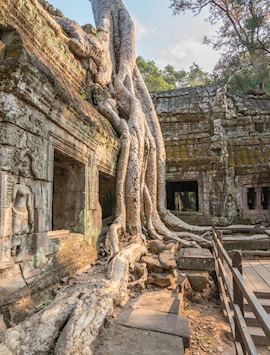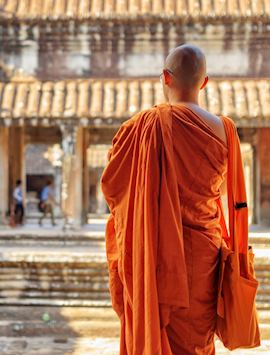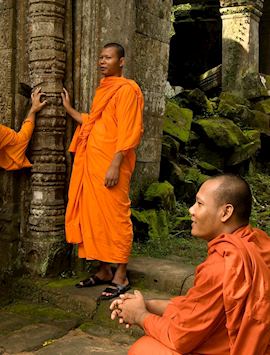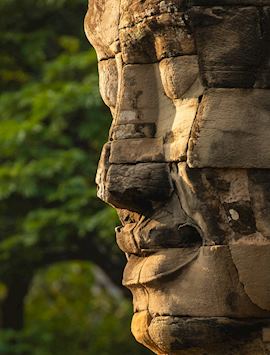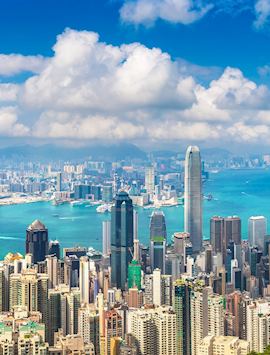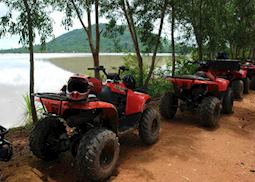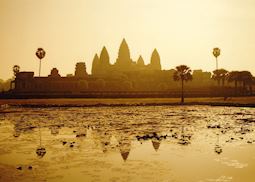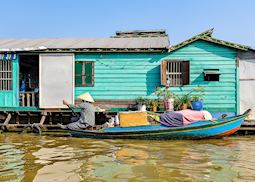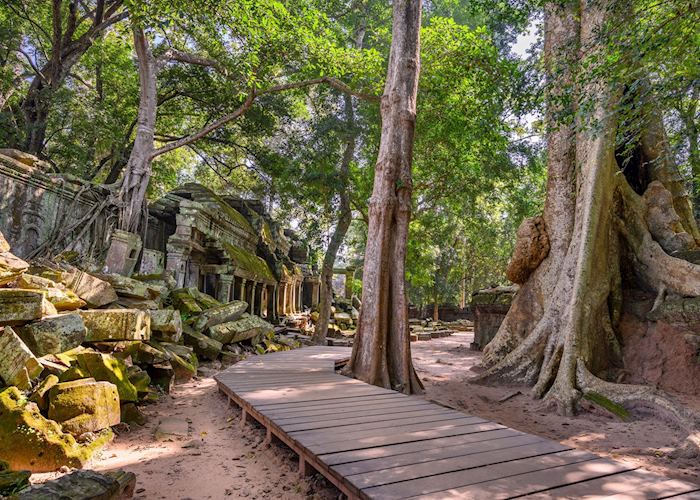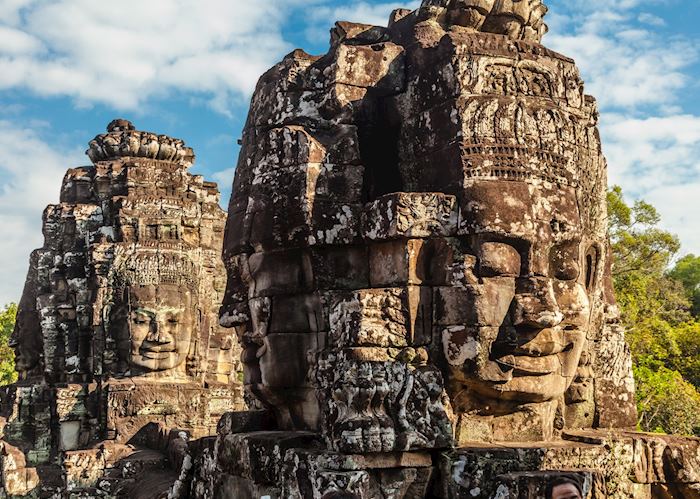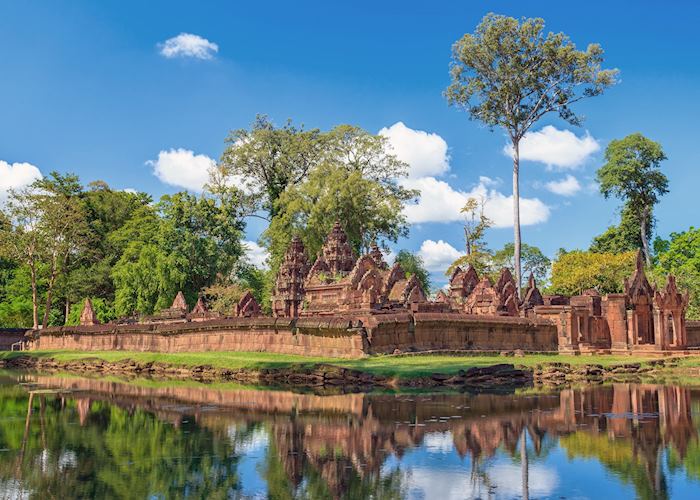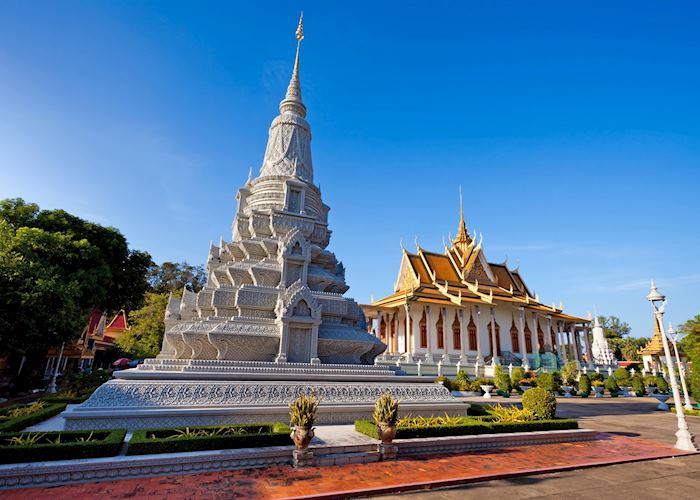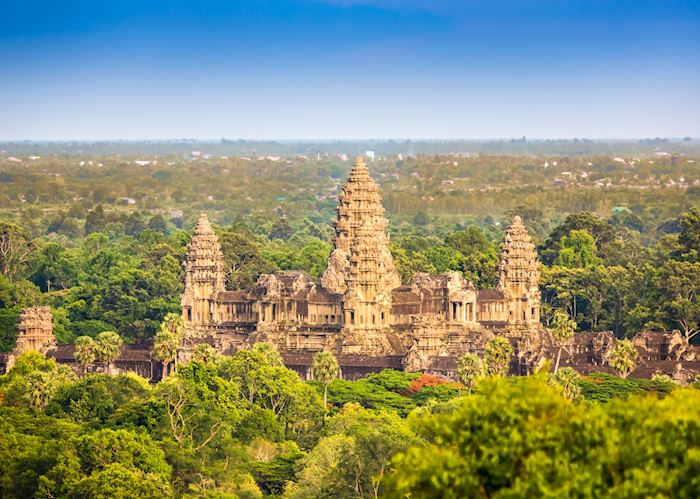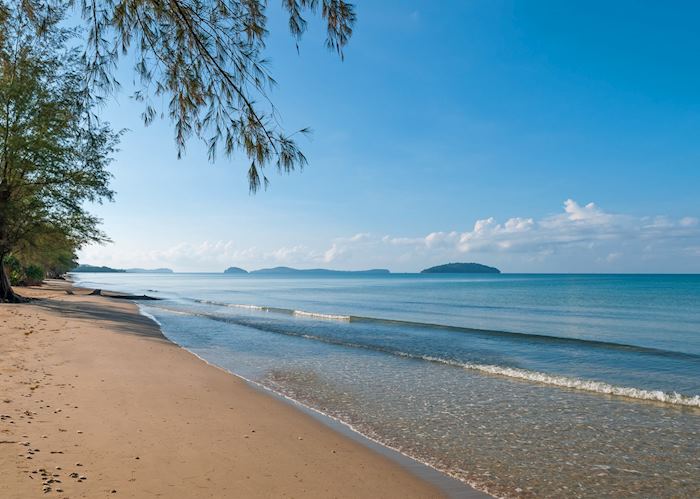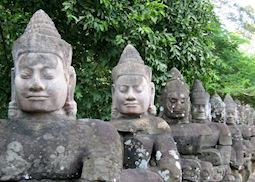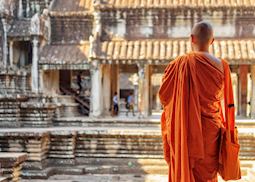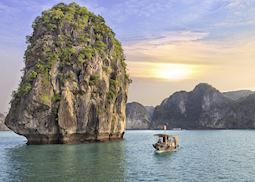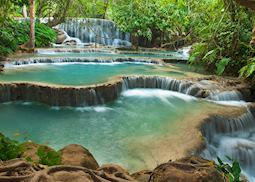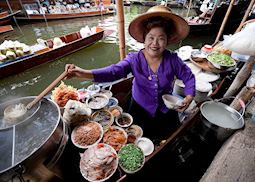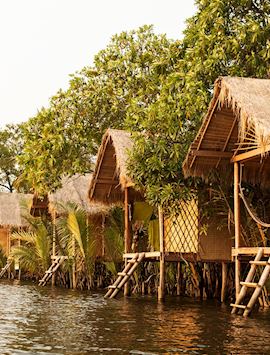
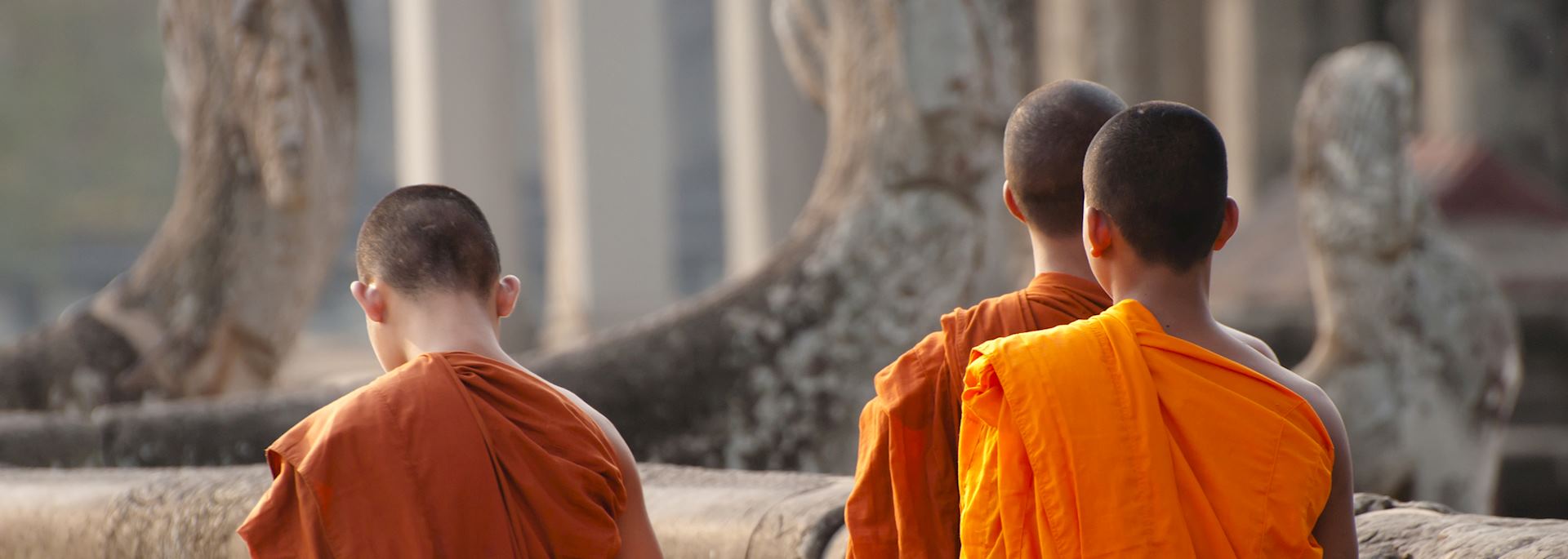
Tailor-made Cambodia vacations shaped around your passions
The intricately carved Temples of Angkor are Cambodia’s main draw, but elsewhere in the country you’ll find vibrant minority villages and great swathes of wilderness. Our Southeast Asia specialists have visited Cambodia time and time again, meeting knowledgeable guides and seeking out comfortable beds in sublime locations. Aiming to take you beyond the obvious, our specialists can build a tailor-made itinerary to help you make the most of your Cambodia vacation.
Gradually reclaimed by jungle over hundreds of years, Angkor’s temples still retain their mystery and we can point you toward some of the smaller, lesser-visited sites. French colonists have left behind a legacy of European-style villas and baroque-influenced gardens, best seen along the boulevards of Phnom Penh. To the northeast, the hills and forests shelter wild elephants and mighty waterfalls, as well as resilient minority peoples. To the south you can soak up the relaxed atmosphere of sleepy coastal towns and enjoy the local delicacy, crab.
Suggested tours for Cambodia
Take an in-depth tour of the temples at Angkor, haggle at the Russian market in Phnom Penh, and search for rare Irrawaddy dolphins in Kratie. Our suggested itineraries are a great starting point as you begin to plan your trip to Cambodia.
Suggested activities for Cambodia
Enjoy sunset at Angkor Wat, learn to make traditional Khmer dishes in a private class, and see elephants close up at a sanctuary. Whatever your interests, our specialists will suggest experiences designed to enhance your trip to Cambodia.
-
Siem Reap quad bike exploration ![Quad biking in Siem Reap, Cambodia]()
Siem Reap quad bike exploration
Siem ReapSiem Reap quad bike exploration
Follow your guide into the countryside immediately surrounding Siem Reap for an insight into a different side of Cambodia seeing how local people live and taking in the rural scenery.
View details -
Angkor Wat at sunset ![Angkor Wat, Cambodia]()
Angkor Wat at sunset
Siem ReapAngkor Wat at sunset
Believed to be the world's largest religious building, this temple is the perfect fusion of symbolism and symmetry and a source of pride and strength to all Khmers. Watching the sun set, sat on one of the temple's ancient walls is a magical experience.
View details -
Kompong Khleang & the Tonle Sap ![Kompong Khleang village, Tonle Sap]()
Kompong Khleang & the Tonle Sap
Siem ReapKompong Khleang & the Tonle Sap
Travel southeast to one of the largest and least-visited villages on the Tonle Sap Lake, Kompong Khleang, about 55 km from Siem Reap. It has a population of about 10,000 people, all of whom make a living from the fishing industry.
View details
Why travel with Audley?
- 100% tailor-made tours
- Fully protected travel
- Established for over 25 years
- 98% of our clients would recommend us
Best time to visit
Our specialists advise on the best months to visit Cambodia, including information about climate, events and festivals.
Request our brochure
Covering all seven continents, The World Your Way shows you how you can see the world with us. It features trip ideas from our specialists alongside hand-picked stays and experiences, and introduces our approach to creating meaningful travel experiences.
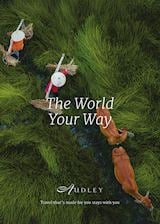
Useful information for planning your vacation in Cambodia
As in most of Southeast Asia, the staple food in Cambodia is rice, which is traditionally eaten with almost every meal. But, the list of accompaniments is a seemingly endless, with rich soups, curries, and vegetable-based sauces, fragrant with fresh mint, lemongrass, coriander, and fish sauce.
Amok, steamed fish wrapped in a banana leaf, and lok lak, a beef dish served with a pepper dipping sauce made from Cambodian pepper, are particular highlights. The complex history of Cambodia is also reflected in its cuisine, with Indian, Chinese, French, and Portuguese influences shaping many of the noodle soups and street food you’ll find on a food tour of Phnom Penh.
The official language of Cambodia is Khmer, although many people working in hotels, cafes, and restaurants speak English.
Cambodia’s local currency is the Cambodian riel (KHR), but US dollars are also widely used.
For the latest travel advice for Cambodia, including entry requirements, health information, and the safety and security situation, please refer to the State Department website.
The temples of Angkor are Cambodia’s main draw, which you can explore with an expert guide, on a cycling tour, or even with a specialist photographer. You can pair this with the country’s more modern history in Phnom Penh — this might include visiting the Killing Fields of Choeung Ek with a local guide or taking a tour of the city’s microbreweries and Khmer cafes.
Cambodia also has a wild, biodiverse landscape, where you can shadow wildlife rangers as they patrol the jungle, cruise down the Mekong at sunset, or search for Irrawaddy dolphins in Kratie. When you need to relax, you can head to the coast to take alfresco cooking classes, walk along the beach, or snorkel among thriving coral gardens.
Siem Reap, the kick-off point for exploring the temples of Angkor, is a key place to explore. But that’s just the start. You could spend time among the gleaming skyscrapers and gilded temples of Phnom Penh, cafe-hop in the French-colonial town of Battambang, or watch the fishing boats arrive into the coastal port in Kep.
Outside the towns and cities, Cambodia’s jungles, plains, and islands are an often overlooked highlight. Koh Kong is a sleepy coastal region where you can relax in a low-key guesthouse or head into the Cardamom Mountains. For a more traditional beach escape, the islands around Sihanoukville offer long, brilliant-white sands. Read more about our top places to visit in Cambodia.
From floating tents in the middle of the Cambodian wilderness to luxurious private islands, there’s a wide variety of places to stay in Cambodia. In the cities, properties range from restored historic buildings with a rich history to modern edifices with every facility you could possibly want. In more rural areas, family-run guesthouses will immerse you in local life, while the coast and islands have a range of secluded beach retreats. You can see our hand-picked range of stays, tested by our Cambodia specialists, on our hotels page.
It takes around 29 hours to fly to Cambodia from the US, depending on your departure airport. You can’t fly to Cambodia direct from the US, but there are regular connections to Phnom Penh via Kuala Lumpur from most large airport hubs, including LAX, JFK, and SFO.
We recommend combining a trip to Cambodia with time in Vietnam or Thailand to make the most of your experience, as well as breaking up your flying time.
The time zone in Cambodia is UTC +7.
While there are public transportation options, the best way to get around Cambodia is by car. This gives you the flexibility to stop whenever you like and travel at your own pace. In Phnom Penh, you could live like a local and explore the city on a Vespa with a local guide, while in smaller towns and rural areas, we could arrange a cycling or kayaking tour. Our Cambodia specialists can arrange your trip complete with a private driver.
Use our travel tool to find up-to-date visa and passport requirements for Cambodia. Enter where you’re traveling to and from (including any stopover destinations en route or flight layovers), along with your intended travel dates and passport details, for a full list of requirements.
Your doctor can provide you with immunization advice for Cambodia, but we recommend you’re up to date with the recommended vaccinations for your home country. You can also check the recommended vaccinations by visiting the Centers for Disease Control and Prevention website.
If you’re traveling to Cambodia from a country considered to be at risk of yellow fever, you may be asked to provide proof of vaccination against the disease on arrival. Consult your GP for up-to-date advice.
Cambodia in pictures
Our expert guides to traveling in Cambodia
Written by our specialists from the viewpoint of their own travels, these guides will help you decide on the shape of your own trip to Cambodia. Aiming to inspire and inform, we share our recommendations for how to appreciate Cambodia at its best.
-
![Vacations in Cambodia]()
Our 2-minute introduction to Cambodia's highlights
Thinking of going on a vacation to Cambodia? A country of saffron-robed monks, age-worn temples in the jungle and bustling markets and riverfronts awaits you. Watch our 2-minute introduction to Cambodia's sights, landscapes and people.
-
What to do in Cambodia: our highlights guide ![South Gate of Angkor Thom]()
What to do in Cambodia: our highlights guide
What to do in Cambodia: our highlights guide
Think Cambodia and the famous temples of Angkor might automatically come to mind. However, our guide encompasses diverse destinations, from fishing villages to the capital Phnom Penh, and the elephants in the remote hills of Sen Monorom,
Read this guide -
Top 5 luxury experiences in Cambodia ![Waterfall at Shinta Mani Wild]()
Top 5 luxury experiences in Cambodia
Top 5 luxury experiences in Cambodia
Cambodia specialist Rachel shares some of the best luxury experiences that Cambodia has to offer. She recommends how to get off the beaten path in style, where to go for a luxe beach getaway, and an exclusive way to see the temples of Angkor.
Read this guide -
Angkor Wat & the temples of Angkor ![Buddhist monk at Angkor Wat]()
Angkor Wat & the temples of Angkor
Angkor Wat & the temples of Angkor
The temples of Angkor are comprised of one of the world's greatest man-made wonders and if you travel with Audley we will recommend ways to appreciate some of the busiest sites and would encourage you to visit some of the less-known temples further afield.
Read this guide -
Cambodia family vacations: timeworn temples and jungle adventures ![Ta Prohm]()
Cambodia family vacations: timeworn temples and jungle adventures
Cambodia family vacations: timeworn temples and jungle adventures
Cambodia specialist, and Siem Reap ex-resident, George explains why he sees Cambodia as an ideal family vacation destination. He has picked out experiences that are suitable for children, from exploring temples deep in the jungle to counting the gemstones in Phnom Penh’s glimmering Royal Palace.
Read this guide
